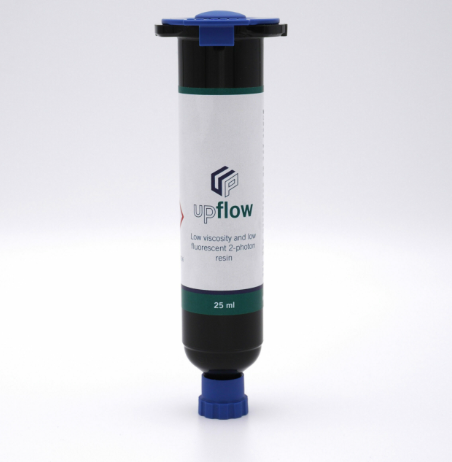Excessive-resolution micro-scale 3D printing firm UpNano GmbH has introduced the event of UpFlow, a photopolymerizing materials.
This materials allows fast and exact 3D printing of micro-environments for a brand new kind of dynamic cell tradition. Developed by Australian IVF specialist Fertilis, it gives a extra managed and fewer variable surroundings for embryos previous to implantation and extra carefully resembles the human physique than different merchandise which might be at present out there. Using an UpNano NanoOne 2PP 3D printer permits for a 30-40% discount in implantation cycles, that are generally required to turn into pregnant, saving sufferers’ emotional and monetary ache.
“Our gadget permits fertilization, embryo tradition, and embryo cryopreservation to happen within the one construction – no extra transferring embryos round by hand. This, in actual fact, will increase the success charge considerably and reduces time, prices, and stress for the dad and mom,” mentioned Marty Gauvin, CEO of Fertilis.

How this novel expertise can ease the IVF course of?
Based on Fertilis, in vitro fertilization (IVF) is a tense time for each dad and mom and embryos. To maintain them secure and wholesome in the course of the pre-implantation part, they should be uncovered to continually altering circumstances. This not solely causes important stress but additionally will increase the chance of failure, necessitating repeated IVF cycles. Fertilis developed and patented a brand new surroundings for the important life part between fertilization and implantation of the embryo so as to cut back stress on the embryo and improve IVF success charges. This “first-of-its-kind” 3D printed micro-device has options 0.05mm in diameter and allows IVF professionals to precisely management and monitor the fertilized egg culturing course of, eradicating the necessity for IVF professionals to maneuver cells between Petri dishes.
“UpFlow affords a decrease viscosity than another 2PP materials with comparable biocompatibility. This enables for a lot superior post-production processing, particularly the flushing of the very tremendous channels so as to take away unpolymerized materials and make sure the reproducibility of structural components,” mentioned Denise Hirner, Chief Working Officer and Co-founder of UpNano.
UpNano completed this by deciding on particular base resins for the UpFlow materials that preserve the low viscosity till a last UV publicity solidifies the fabric and makes it prepared to be used. Different advantages of the fabric embrace its excessive optical transparency, which makes it supreme for microscopic inspections of incubated embryos, and its very low autofluorescence.
Fertilis employs UpFlow mixed with a NanoOne printer which was just lately provided to the Australian Nationwide Fabrication Facility (ANFF) on the College of South Australia. This printer not solely enhances the standard of the 3D-printed micro-device for embryo incubation but additionally the manufacturing velocity. CEO of Fertilis additional defined, “Beforehand, the 3D printing of our microfluidic gadgets took a full fortnight. Now, 4 hours solely. That’s an distinctive acceleration of the manufacturing course of. And, better of all of it, utilizing UpFlow ends in a better-quality product than achieved earlier than.”
Utilizing a NanoOne additionally permits for optimum benefit of its adaptive decision expertise. This could change the main focus width of the laser beam whereas printing. Bigger and smaller options could be printed in a single go, enhancing manufacturing time and high quality. UpNano claims that the event of UpFlow demonstrates the “monumental potential” of 2PP 3D printing for cell and medical analysis. UpNano demonstrated this by introducing X Hydrobio INX U200, the one commercially out there resin that permits embedding dwelling cells immediately from a tradition dish inside extremely exact 3D printed buildings for organic purposes.

Additive manufacturing scaling the organic sector
Just lately, CollPlant, a 3D bioprinting specialist, expanded its materials portfolio with the addition of a brand new bio-ink. CollPlant’s second recombinant human collagen (rhCollagen)-based materials, dubbed ‘Collink.3D 90,’ is claimed to have improved mechanical properties that particularly goal the print calls for of onerous and delicate tissues. When put next with present cell-culturing hydrogels, the ink is claimed to permit for fast cell migration, which might make it a really perfect basis for creating regenerative medicines.
Beforehand, researchers from the College of British Columbia (UBC) efficiently 3D bioprinted human testicular cells, which is believed to be a world first. After discovering some early indicators of sperm manufacturing potential, the researchers hope to make use of their outcomes to assist male infertility. Dr. Ryan Flannigan who’s the examine’s lead creator claims that infertility impacts about 15% of {couples}, with male components being a contributing issue in additional than half of confirmed instances. He added, “We’re 3D printing these cells into a really particular construction that mimics human anatomy, which we expect is our greatest shot at stimulating sperm manufacturing. If profitable, this might open the door to new fertility therapies for {couples} who at present haven’t any different choices.”
Observe this hyperlink for all of the Formnext 2022 information.
To remain updated with the most recent 3D printing information, don’t neglect to subscribe to the 3D Printing Trade publication or observe us on Twitter, or like our web page on Fb.
When you’re right here, why not subscribe to our Youtube channel? That includes dialogue, debriefs, video shorts, and webinar replays.
Are you searching for a job within the additive manufacturing trade? Go to 3D Printing Jobs for a number of roles within the trade.
Function picture exhibits UpNano’s resin UpFlow. Picture by way of UpNano.